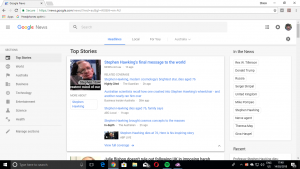The battle’s on for streaming-music services
Articles

Spotify’s ad-supported free music service faces competition from Amazon and Google
Free ad-supported service tier
Amazon Music’s free ad-supported tier goes live, but only for Alexa users | The Verge
Hi-Fi-grade premium service tier from Amazon
Amazon may be working on a high-fidelity music streaming service | Engadget
Amazon Planning To Hi-Fi Music Streaming Service: Report | Android Headlines
Amazon Music rolls out a lossless streaming tier that Spotify and Apple can’t match | The Verge
From the horse’s mouth
Amazon
Amazon Music HD (Product Page – Sign up here)
My Comments
The Silicon Valley establishment are realising that other companies are offering streaming-music services that offer service options that they don’t provide in their own services.
Ad-supported free-to-end-user service tier

The Amazon Echo will benefit from Amazon’s free music service
One of these is a free-to-end-user service option which is supported by audio advertising that plays in a similar manner to commercial free-to-air music radio.
Spotify had, for a long time, established its streaming-music service on a “freemium” model with an ad-supported basic service tier free to the end-user. This is alongside their Premium service tier which can be fully enjoyed on your mobile device or Spotify Connect endpoint audio devices and without advertising.
The advertising models included display advertising on the user interface along with radio-commercial-type audio ads at regular intervals. They also offer to marketers advertising ideas like sponsored playlists or sponsored listening sessions.
Now Amazon and Google are offering a free-music ad-supported streaming tier for their “online jukeboxes” but this will be limited to their smart-speaker platforms rather than a Web-based or mobile-based experience. There will also be a limited music offering available through this music tier.
Premium hi-fi-grade service tier

Amazon to undercut Tidal and Deezer when delivering a streaming music service fit to play through hi-fi equipment
The other is a premium streaming service that yields at least CD-grade audio fit to be played through that hi-fi system rather than an experience similar to FM radio.
TiDAL and Deezer based their music-streaming service on listeners who value high-quality sound for a long time. You may have heard music streamed from one or both of these services if you have recently attended a hi-fi show like any of the Chester Group hi-fi shows where I have heard TiDAL in action, or visited a boutique hi-fi or home-AV store.
Amazon aren’t taking this lightly and are offering the HD and Ultra HD service tiers which are the hi-fi-grade premium service tiers for their Amazon Music Unlimited streaming-music service. This is priced at US$15 per month with a view to undercut TiDAL and Deezer and is also targeted towards people who use Alexa-platform audio devices with their hi-fi system or use an Alexa-based network multiroom setup.
The Amazon service offers the high-quality service as two tiers – the HD one that is equivalent to CD quality and the Ultra HD one that is equivalent to “master quality”. These use the FLAC codec to trasfer the music to your equipment and you may find that the HD tier is similar to what you get if you are “ripping” a CD to FLAC files with, perhaps, Windows Media Player in Windows 10. They are working with the record labels to license their music libraries to this service in order to have more high-grade content.
What is this to lead to
I see this opening up the floodgates for a highly-volatile streaming-music service market with companies wanting to cut in with entry-level free tiers driven by advertising or premium hi-fi-grade subscription tiers for those who value high-quality sound. Here, I would see at most of these companies running a three-tier music service for consumers – an ad-supported limited-content free service, a standard package with the whole library delivered ad-free and a premium package that has access to the whole library with CD-grade or master-grade audio.
There will be some factors that will allow each streaming-music service to differentiate themselves in a crowded market. They will become more important as a way to attract new subscribers or retain their existing subscriber base. It will also become important in encouraging people who have subscriptions with all of the services to focus their attention to a particular service.
One of these would be the quantity and quality of music playlists, especially curated playlists. Another would be the richness of information available to the user about the performers, composers, genres and other factors regarding the music library.
There will also be whether the music library contains underrepresented content and how much of this content is available to the users. This includes whether they offer a classical-music service with the expectations of such a service like composer-based searching.
Another issue that will show up is the provision of client-side support in standalone audio equipment so you aren’t running extra software on a computer or mobile device to get the music from that service to the speakers. This will also include having software for these services integrated in your car’s dashboard.
There will be the issue of what kind of partnerships the streaming-music service provider can have with the business community. It ranges from “business music” service tiers with music properly licensed for public-performance on business premises to advertising and sponsorship arrangements like what Spotify has achieved.
As far as the creative team behind the music is concerned, a differentiation factor that will come about is how each streaming-music service renumerates these teams. It is whether they are the composers, arrangers, lyricists or music publishers behind the songs or the performers and record labels behind the recordings.
There will also be the issue of encouraging other vendors to tie-in streaming-music subscription as part of a package deal. This could be through an ISP or telco providing this service as part of an Internet or mobile-telephony service plan. Or buying a piece of equipment like an Internet radio could have you benefit from reduced subscription costs for a particular streaming-music service.
What I see of the online music-streaming market is something that will be very volatile and competitive.
UPDATE
19 September 2019 – Amazon formally launches the HD and Ultra HD hi-fi-quality service tiers for their Music Unlimited streaming service.










![10 Downing Street door by Jdforrester crop from original by Prime Minister's Office, HM Government. (2010 Official Downing Street pic.jpg) [OGL (http://www.nationalarchives.gov.uk/doc/open-government-licence/version/1/)], via Wikimedia Commons](https://homenetworking01.info/wp-content/uploads/2016/10/2010_Official_Downing_Street_pic_-_cropped_to_door_arch-259x300.jpeg)